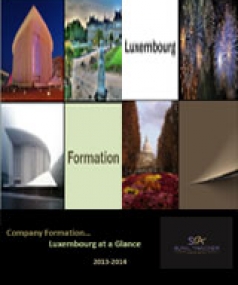The Amendments to UAE Trademark Law
The ideal trademark is one that is pushed to its utmost limits in terms of abstraction and ambiguity, yet is still readable. - Saul Bass
 The UAE has a well-defined law to protect the Intellectual property rights of a business including its brand, business name, logo, etc. One of the most important Intellectual property rights is the Trademark. It gives an exclusive right to a person to use his business name and other elements associated with it. In the UAE, the first trademark law came into force in 1979. Later, Federal Law No 37 of 1992 governed all the trademark-related matters in the country.
The UAE has a well-defined law to protect the Intellectual property rights of a business including its brand, business name, logo, etc. One of the most important Intellectual property rights is the Trademark. It gives an exclusive right to a person to use his business name and other elements associated with it. In the UAE, the first trademark law came into force in 1979. Later, Federal Law No 37 of 1992 governed all the trademark-related matters in the country.
The New Trademarks Law in the UAE
The United Arab Emirates government passed the Federal Trademarks Law No. 36 of 2021 replacing the Trademark law of 1992. The amended new Law came into effect on 2nd January 2022. The new law will regulate the trademarks regime in UAE and it will have a considerable change in the legal domain of trademarks. The New Law will expand the scope of a trademark to cover non-traditional marks including single-color, holograms, sound, scent, and three-dimensional signs. This amendment also includes the registration of geographical names of brands or products associated with the names of specific geographic regions.
Highlights of the new trademark Law (Federal Decree-Law (36 of 2021)) is as follows:
- The trademarks in Article 2 provide an expanded definition covering the more types of non-traditional marks such as 3-D trademarks, single color or combination of colors, holograms, a distinctive sound or smell, etc.
- With the new amendment, the trademark office allows multi-class applications. Now, it is possible to multiclass in a single application. Earlier multiclass are not allowed to be covered under registration in UAE. An application for registration of a group of trademarks may be filed in accordance with Article 9 if they are identical in their essential elements and different in such a way that it does not affect their distinctive identity or character like color, covering the same category of goods or services.
- Any person whether it is a physical person or a legal person can file an application to register a trademark. The application for registration of a trademark may be done by claiming prior user or intent to use mode. The necessary requirement is that the ownership of such marks should not be in dispute. If there is any dispute then, the registration of an application shall be suspended until the dispute is resolved. If the case is in dispute in consideration of any court, then the application for registration can be made after the final judgment by a Competent Court.
- The period to make an appeal of an application has been extended to ninety days has been reduced to thirty days. This change to the limitation of appeals will speed up processes and limit frivolous litigation.
- Article 31 provides that the registration of a trademark no longer constitutes a barrier to a trademark license agreement at the Trademark office. The matter to be taken care of is that the license to use a mark should be in writing and documented. To avoid any dilution there should be due supervision and control of the Licensor over the use of a licensed mark by a licensee.
- Once an application is accepted, it will be published only in the official gazette which is managed and published by the ministry of economy. In the previous law, it has to be published in 2 local newspapers. This also applies to renewals, post-registration, registrations including assignments, and amendments of the applications. The new amendment will not only help in reducing costs for the applicants, but it will also avoid unnecessary arguments regarding the time limit for opposition proceedings.
- The ownership of a registered trademark will not be disputed when it is used for continuous five years from the date of registration. According to UAE law, the registration date and application date are different, hence renewals of the registration are affected for 10 years from the date of application.
- The structure of the Trademarks Grievance Committee has been changed in the new amendment. In the new law, the Trademarks Grievance Committee is chaired by a specialized Judge appointed by the Minister of Justice and two specialized members appointed by the Ministry. All Objections to the decisions made by the Trademarks Office in applications are adjudicated by the aforesaid Committee. The grievance from the decision of the Trademarks Grievance Committee may be appealed to the Federal Court of Appeal.
- A specific Chapter 6 is now been added to the new amendment. It is to elucidate and provide clarity on the issue of Geographical Indications (GIs). These were previously unregulated. These are defined in the New Law as indications showing that a good has originated in a particular territory or in a region, location, or place of that region if that good’s quality, reputation, or any other characteristics are primarily due to its geographical origin. Articles 38 to 44 explain the types of GIs which are to be accorded protection, prohibitions, cases of non-registration of GIs etc. Introducing these articles will give guidance to trademark owners, judges, and all interested parties in GIs.
- The new law of trademark increased the Fines and penalties for the infringement of trademark rights. Article 39 explains the hike in the penalty for the infringement from AED 50,000 to AED 100,000 Dirhams. Article 40 introduces penalties for forging a registered trademark, importing a counterfeit trademark for commercial purposes, knowingly importing or exporting goods bearing a forged trademark etc. For unlawful use of the unregistered mark, selling or offering for sale carrying a forged or imitated trademark, there is a penalty of imprisonment provided which is not to exceed one year, and/or fine of AED 50,000 and up to AED 200,000. In the new law, the re-offenders will be given higher penalties.
 Conclusion
Conclusion
The introduction of the amended UAE Trademarks law is an interesting development with the aim of providing recognition to the rights and the rights exercised by the owner without any hassle. It brings more clarity on widening the definition of a trademark, providing multiclass applications, the constitution of the Trademark Grievance Committee, introducing the protection of GIs, and increasing the severity of penalties and fines in case of infringements, etc. All these features in the new law will help the functioning of the Trademarks Office removing ambiguities. The new law will also bring in line with the Internationally accepted trademark laws and practices.
 عربي
عربي
 English
English Русский
Русский 官话
官话 português
português
 Türk
Türk 




